A soybean can grow to over 2 meters since it is an upright branching plant. The self-fertilizing flowers are white or purple. Most commercial types contain brown or tan seeds with one to four seeds per pod, which are yellow, green, brown, or black. Soybeans do best in sandy loam that is warm, rich and well-drained. All threat of frost has passed at the time of planting. Let’s check out more information about Soybean Farming in USA.
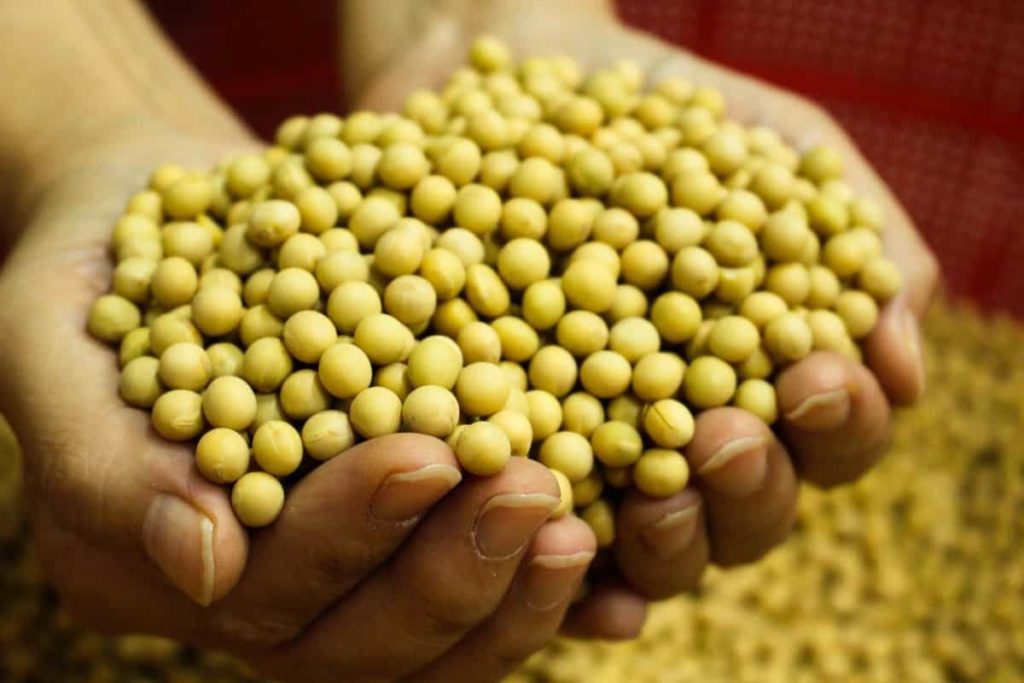
It is common to practice for soybeans to be harvested mechanically once the plant’s leaves have fallen and its moisture content reaches a safe level of 13%. However, because it uses nitrogen-fixing bacteria, this plant, like others, has historically been a significant soil enrichment crop, even though it isn’t now used in most commercial farming methods.
Soybeans are a common food for humans and animals across the globe because of their high protein content and low cost. In addition to oil, the seed contains 63 percent meal, with half that amount of protein. In addition, soybeans lack starch, making them a good protein source for people with diabetes. With so many different climates and soil types in the United States, each farmer’s agricultural situation will impact how they manage soybeans.
This article deals with how to grow soybeans, how soybeans are grown and harvested, soybean harvest time in the USA, where the soybean is grown in the USA, what soybeans are used for, and the details about soybean production by state in the USA.
Soybean production by state in USA
Illinois had the most at 672,600,000 bushels, according to 2021 data. Iowa came in second with 621,910,000 bushels, while Minnesota came third with 356,330,000. Nebraska and Indiana rounded out the top five with 350,900,000 and 335,625,000 bushels. North Dakota came in tenth place with a harvest of 276,900,000 bushels. The Illinois output of roughly 60 bushels per acre established a new record for the state in 2020.
This year’s crops are likely to rise, according to the NASS. However, the weather and other variables might affect this quantity. Late spring in Illinois, for example, means that soybeans will be planted more often than corn, which might lead to a higher yield. In addition, because of their better profitability than corn, soybeans may persuade more Illinois farmers to grow them in the future, independent of the weather. Since 2012, the nation has seen a shift from maize to soybeans.
Iowa’s yields are likewise expected to rise shortly. The state expects to produce an average yield of 58 bushels per acre. This output was achieved despite Iowa’s severe dry weather, particularly in late July. Soybeans have been planted on 9.94 million acres in Iowa, and the state expects to harvest 9.84 million of those acres. A small German immigrant family has practiced soybean cultivation in Arkansas, the final state on the list, since 1926.
In case you missed it: Top 19 Steps to Boost Soybean Yield: How to Increase Production, Quality, Size, and Tips
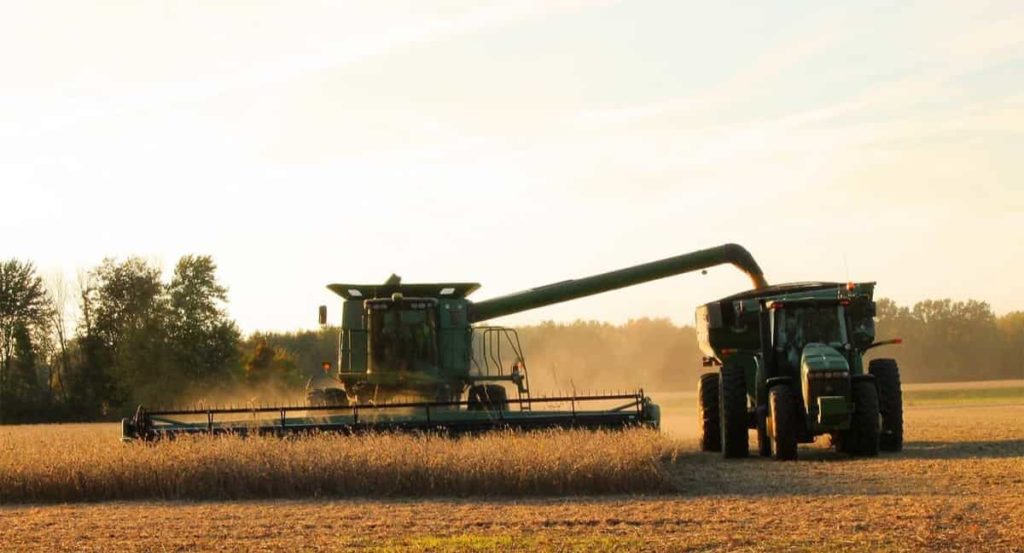
The state’s primary cash crop at the time was rice. Soybean growing was primarily motivated by rice’s depleting the soil’s nutrients. In 2017, soybeans were grown on over 3.5 million acres of land in the state. In 2016, the crop brought in $1.4 billion in revenue, or around 20% of the total income generated by the agricultural industry. Soybean acreage yields have risen to an average of 50 to 60 bushels in recent years.
| Rank | State | Production (M bu) |
| 1 | Illinois | 672.6 |
| 2 | Iowa | 621.9 |
| 3 | Minnesota | 356.3 |
| 4 | Nebraska | 350.9 |
| 5 | Indiana | 335.6 |
| 6 | Missouri | 276.9 |
| 7 | Ohio | 275.7 |
| 8 | South Dakota | 215.6 |
| 9 | Kansas | 189.6 |
| 10 | North Dakota | 181.6 |
| 11 | Arkansas | 153.5 |
Soybean cultivation for beginners
Seed selection
Soybeans are cultivated from seeds harvested from the field the year before. Soybean seeds are cleaned and packed with mature soybeans intended for use as seeds. High yield, drought resistance, color, and weather resistance are some of the plants features farmers look for while selecting seeds.
Tilling
Clean till
All previous crop leftovers must be buried by ploughing, disking, or other equipment. Use this strategy on fields not in danger of water or wind erosion.
Reduced till
To improve residual interaction with the soil, some tillage is required. Microbial decomposition of residue is facilitated by better soil-residue interaction, which minimizes erosion. The usage of a wide range of tools is possible.
No-till
The fresh crop is planted immediately into a stale seedbed without any tillage before planting, except for mowing the residue from the previous crop. It is essential for healthy stands of crops that planters can cut through previous crop residue and securely re-seal the seed furrow. Seed germination can be slowed in no-till seedbeds because of the colder and wetter conditions. No-till planting often necessitates the use of seed treatments. A no-till system gives the best possible defense against water and wind erosion.
In case you missed it: Best Fertilizer for Soybean Crop: Organic, Compost, NPK, When and How To Apply
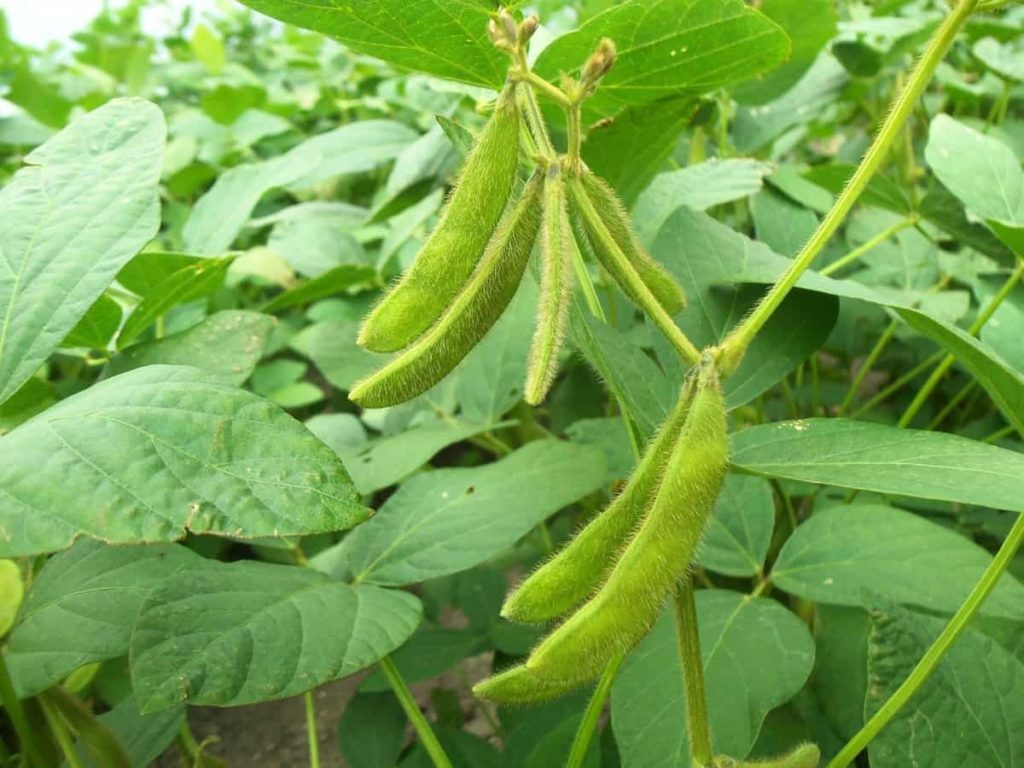
Farmers in several soybean-growing areas are increasingly turning to no-till farming to save money on tillage inputs while protecting soil erosion. Conservation-tillage systems need uniform distribution, good weed control, seed planting, accurate planter adjustment, soil testing, and fertilizer management.
Planting soybean
Planting dates for soybean
When there is a sufficient moisture supply in the soil, soybeans can be planted on many dates. According to research conducted at many universities, soybeans planted earlier in the growing season often have better yields than soybeans planted later in the growing season. Because planting, not perfect seedbeds results in a decrease in yield rather than an increase, farmers who start their seeds early need to ensure that the seedbed is in the appropriate circumstances.
Other essential factors to consider include the presence of soil pathogens, the amount of pest pressure, and the prospect of frost. Seed or in-furrow treatments with fungicides, insecticides, or nematicides are some of the alternatives available to help lower the danger of soil diseases and the amount of insect pressure. It is essential to be aware of the likelihood of frost, particularly in the northern growing zones, since this can assist in deciding how early seed can be safely stowed.
When it comes to determining the yield potential, the pattern and quantity of rainfall during pod formation and grain filling have a significant impact. When there is a significant potential for drought and heat challenges, varying the planting dates might be a helpful strategy.
Row width for Soybean Farming in the USA
The row width that farmers plant their crops in might vary greatly depending on their preferences. Planting rows with a width of no more than 7 inches apart is acceptable for farmers who use grain drills. Other popular row spacings are 15 inches, 30 inches, and even 40 inches in the south, but 15 inches is the most common row spacing. According to studies, narrow rows provide yields comparable to or even higher than those produced by 30-inch rows in environments with high yield potentials.
Light capture, Early canopy cover, weed control, and decreased erosion are some of the benefits of using narrow rows. However, tight row spacing can lead to worse stands than wider row spacing with the same number of seeds. Narrower row stand difficulties might be reduced or eliminated if the planting speed, planter unit down pressure, and proper press wheel pressure were adjusted appropriately.
Planting rate
A certain area’s plant population can be defined as the total number of seeds that have been sown there. Plants or seeds per acre are the most common way to measure population density—both the number of plants and the breadth of a row influence canopy closure and other yield components. For example, the canopy will shut more quickly, and the soil will retain more moisture if the seed population increases.
High yields aren’t always associated with large plant populations. Seeding rates of 125,000 to 140,000 seeds per acre are generally advised in the soybean belt. Still, it’s good to check with state Extension agronomists for specific recommendations in your region. Plant density rises as the row spacing becomes smaller and the quantity of seeds per linear foot of row falls.
To make up for the shorter growth season by increasing the number of nodes per plant, later planting dates may need a higher plant density. In addition, plant densities may need to be increased in low-yielding conditions. However, changing plant density may not be necessary in better-producing situations.
In case you missed it: Organic Soybean Farming, Production Process
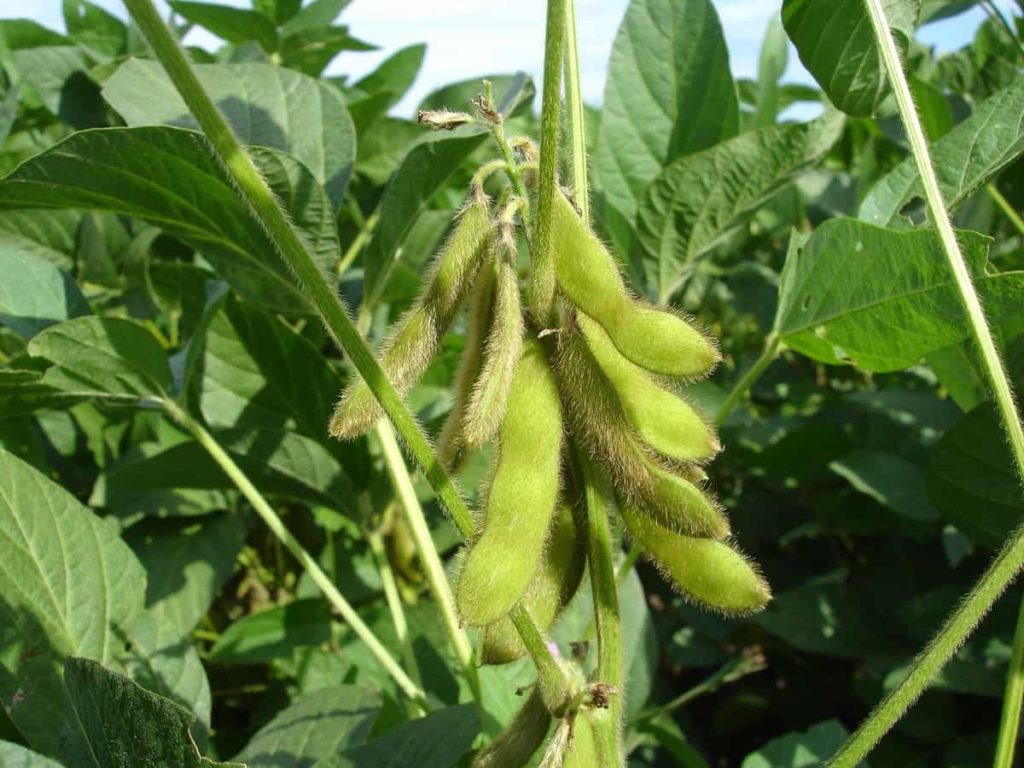
Planting depth
When the circumstances of the seedbed are favorable, the ideal planting depth is between 1 and 11⁄2 inches. Planting crops later in the season when circumstances are dry necessitates planting them deeper so that the seeds can come into touch with moisture. When planting early, lay seeds a little lower in the ground to cut down on the amount of time before they emerge.
The crusting of the soil leads to poor standing. Deep seed planting aggravates it, resulting in increased disease pressure from soilborne pathogens. The deeper the seed is put, the more severe the problem.
Soybean crop management
Lime and fertilizer needs can both be determined using the results of a soil test. Because of their symbiotic association with Bradyrhizobium bacteria, soybeans do not need extra nitrogen fertilizer if they are properly treated for phosphate and sulphur and if their pH is appropriate. This is because soybeans are capable of fixing nitrogen on their own. Band-applied fertilizer must be two inches to the side and two inches below the seed.
It is essential that the soybean seed does not come into touch with any fertilizer. It is not recommended that diammonium phosphates or urea be used in the fertilizer band. Also, during the planting process, you should not apply more than 40 pounds of potassium in the fertilizer band. If there are alternative crops, like corn or grass hay fields, that can benefit from the nitrogen; then soybean fields are not the greatest choice for optimizing the value of manure nutrients. Instead, maize or grass hayfields are the best options.
However, the addition of manure offers advantages beyond only the delivery of nitrogen. There are valid reasons to apply manure to areas that will be cycled to soybeans in the future. For instance, manure provides a source of nutrients in addition to nitrogen. In situations where low soil test levels indicate a possible response to phosphorus, potassium, sulphur, or micronutrients, manure is a suitable alternative to give these nutrients since it already contains them.
In addition, harvesting soybeans removes nutrients from the crop, including phosphate, potassium, and sulphur; thus, using manure instead of purchasing fertilizer may minimize the required amount. When manure is put into legumes, the process of nitrogen fixation is slowed down but does not stop entirely. When nitrogen rates are higher than 50 percent of the amount of nitrogen that the crop can remove, more nitrogen is at risk of being lost.
As a result, it is advised that manure applications be restricted to rates that deliver no more than fifty percent of the anticipated N removal based on estimations of manure’s nitrogen credit. For example, for an expected soybean yield of 30, 45, or 60 bu/acre, the nitrogen credits from manure shouldn’t exceed 50, 75, or 100 pounds of nitrogen eliminated per acre. The reduction of risk associated with accommodation will also result from capping rates at these levels.
In case you missed it: Soybean Seed Germination, Time, Temperature, Process
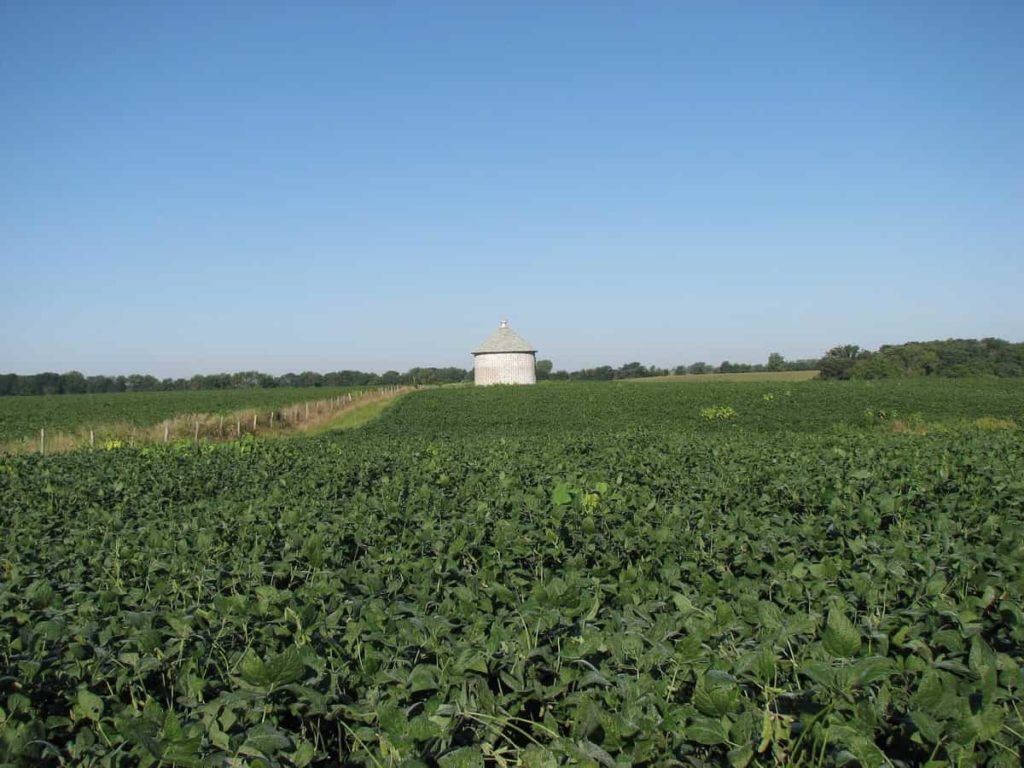
If manure runoff and nitrogen volatilization are issues., it is advisable to inject or integrate the manure quickly after it has been applied. Rates need to be recalculated after taking into account the various application options. Manure applied to corn stubble in corn grain-soybean cycles can help break down corn crop waste. However, manure applied to row crop systems in the autumn could boost nitrate leaching in the winter and early spring.
Similarly, applying liquid manure on the soil’s surface without integration will likely result in nitrogen loss via volatilization. It is possible to apply too much phosphorus when manure is used as a source of fertilizer, which is another factor to consider. Phosphorus removal from soybeans can vary, but it is normally somewhere about 0.8 pounds of P2O5 per bushel. Manure should not be applied to soils with high phosphorus levels because it will raise the amount of phosphorus in the soil and increase environmental risk without benefiting agricultural productivity.
When applying manure to soybeans, disease pressure is another factor that must be considered; fields that have a history of diseases, such as pythium and white mold, have a greater chance of seeing an increase in disease pressure as a result of the application of manure. As a result, applying manure to fields in this condition is not encouraged. The most common reason for poor soybean yields in August is dryness, which occurs at the time when the seeds contained inside the pods are expanding and filling.
The crop is extremely resistant to dryness until that point, but moisture stress in August leads pods to shed and seeds to abort, which is common. Because of this, it is strongly suggested that soybeans not be cultivated on soils that are sandy or gravelly. It is very uncommon for soybeans to get lodged before harvest, but contemporary combines are built to manage crops that have been lodged.
Once the plant has reached maturity, the leaves fall off, leaving just the stems and pods to be processed by the machine. Soybeans can be kept at 14% moisture. However, if they are handled harshly, particularly when they are extremely dry as they often are when they are stored during the coldest months, they are more likely to crack or shatter.
Growth of soybeans
After sowing, soybeans typically sprout between four and seven days later. At this time, the farmer has already made significant investments in seed, pest treatments, and operation expenses; thus, there are many things a farmer should consider to safeguard his crop. When a farmer discovers a large bug infestation, they have a responsibility to evaluate the level of threat that the infestation poses to the crop.
Bugs and worms are particularly fond of young, sensitive plants. If the infestation is severe enough to cause damage to the crop, the farmer needs to use a pesticide. There are still substances that can be sprayed when employing organic techniques, but the choice is considerably less and greater dangerous.
Weeds are an additional danger to the young crop since they develop higher than soybean plants. They have the potential to suffocate the soybean plants, which will prevent them from receiving the sunshine and nutrients that are essential to their growth. This will result in a lower yield of soybeans. In addition, some weeds can produce seeds that will be harvested with soybeans, decreasing the crop’s value. After harvesting the produce, the farmer will get a lower price when they sell it.
The flowers appear throughout July, August, and September on the plants. The blooms are very delicate and may range in color from pure white to a stunning violet or deep purple. These flowers will eventually develop into little pods that will house the immature seeds on the soybean plant. Because the soybean plant can self-pollinate, each blossom contains male and female reproductive structures.
A single plant can create its seeds and, in effect, clone itself. It is common for soybean plants to produce many flowers but not enough pods. The tops of soybean leaves have a dark green color, while the undersides of the leaves are a little lighter, silvery-green color.
Crop rotation is essential for soybeans
Soybean cyst nematode and other soybean diseases, such as Phytophthora root rot, sudden death syndrome, and frog-eye leaf spot, make it difficult to grow soybeans continuously for many years. Soybean gall midge, for example, might be more of an issue under continuous cropping. Compared to monocultures, crops in rotation with soybeans often gain an advantage. Soybean yields are higher when rotated than planted as a continuous mono-crop in a no-till system.
Crop rotations also reduce pest pressure. Herbicide resistance can be delayed if soybeans are alternated with a grass crop such as maize, wheat, or sorghum, and various modes of action are used. A reduction in disease-carrying residues is another benefit of rotating crops.
In case you missed it: Soybean Farming Information Detailed Guide
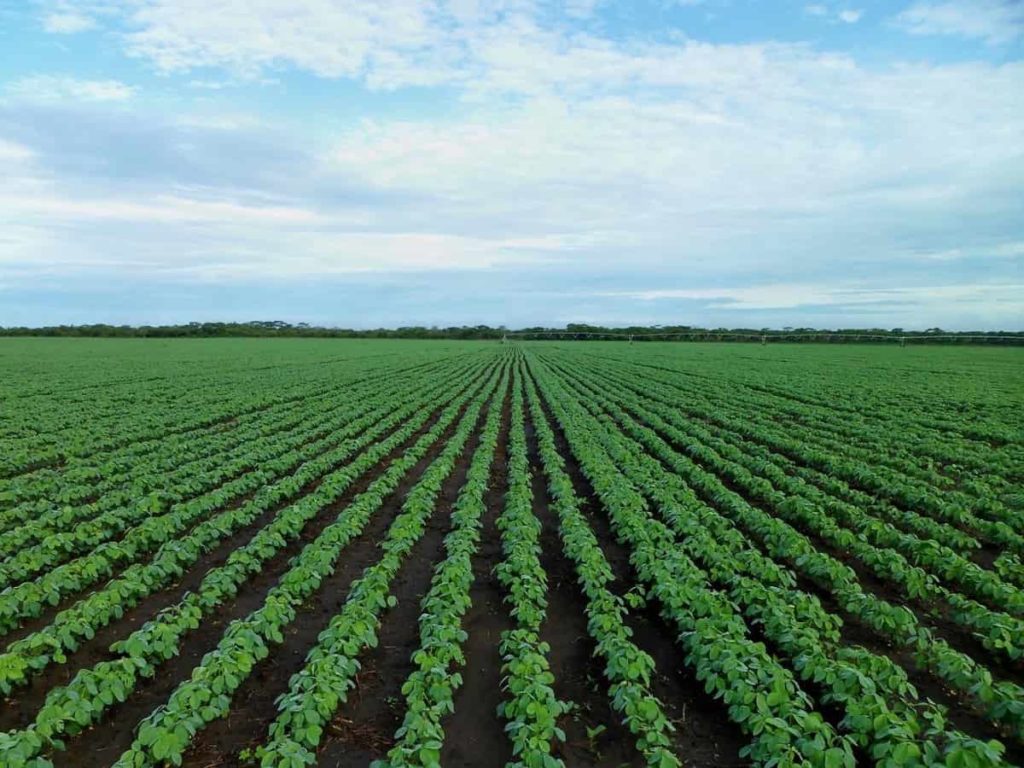
Harvesting of soybeans
Soybeans begin to develop by the end of September. Soybean plants’ leaves become yellow as the days shorten and the temperature falls. The ripe soybean pods will be seen after the leaves turn brown and fall off in the middle of October or November. To be precise, the soybeans are now ripe enough for harvest. Soybeans, maize, and wheat are harvested using combined harvesters and massive harvesting machines.
Header, front of combine, chops, and gathers soybean plants. After separating the pods and stem from the beans, the combine takes the beans to a tank at the rear of the machine, and stored until harvest time. The soybeans will be emptied onto a grain truck or grain wagon when the tank is full. When soybeans are not sold immediately, they are either held at storage facilities or transported straight to a grain dealer in grain trucks. A processing facility is used to separate the soybean meal from the soy oil components once the soybeans are harvested.
Conclusion
If you plan to cultivate Soybeans in the United States, this article will help you start growing soybeans from scratch.
Disclaimer: The subject that has been presented in the essay up to this point is just for educational purposes and may lead to different outcomes when put into practice. There is no way that the author could be held responsible for any mistakes that could occur in agricultural procedures as a direct consequence of applying the information presented here.
- How to Make Houseplants Bushy: Effective Tips and Ideas
- Innovative Strategies for Boosting Coconut Pollination and Yield
- Pollination Strategies for Maximum Pumpkin Yield
- The Complete Guide to Chicken Fattening: Strategies for Maximum Growth
- Natural Solutions for Tulip Problems: 100% Effective Remedies for Leaf and Bulb-Related Issues
- Revolutionizing Citrus Preservation: Towards a Healthier, Greener Future
- Natural Solutions for Peony Leaf and Flower Problems: 100% Effective Remedies
- Maximizing Profits with Avocado Contract Farming in India: A Comprehensive Guide
- Natural Solutions for Hydrangea Problems: 100% Effective Remedies for Leaf and Flowers
- The Ultimate Guide to Choosing the Perfect Foliage Friend: Bringing Life Indoors
- From Sunlight to Sustainability: 15 Ways to Use Solar Technology in Agriculture
- The Ultimate Guide to Dong Tao Chicken: Exploring from History to Raising
- The Eco-Friendly Makeover: How to Convert Your Unused Swimming Pool into a Fish Pond
- Mastering the Art of Delaware Chicken Farming: Essentials for Healthy Backyard Flocks
- 20 Best Homemade Fertilizers for Money Plant: DIY Recipes and Application Methods
- How to Craft a Comprehensive Free-Range Chicken Farming Business Plan
- Brighten Your Flock: Raising Easter Egger Chickens for Beauty and Bounty
- How to Optimize Your Poultry Egg Farm Business Plan with These Strategies
- Subsidy for Spirulina Cultivation: How Indian Government Schemes Encouraging Spirulina Farmers
- Ultimate Guide to Raising Dominique Chickens: Breeding, Feeding, Egg-Production, and Care
- Mastering the Art of Raising Jersey Giant Chickens: Care, Feeding, and More
- Ultimate Guide to Raising Legbar Chickens: Breeding, Farming Practices, Diet, Egg-Production
- How to Raise Welsummer Chickens: A Comprehensive Guide for Beginners
- How to Protect Indoor Plants in Winter: A Comprehensive Guide
- Ultimate Guide to Grow Bag Gardening: Tips, Tricks, and Planting Ideas for Urban Gardeners
- Guide to Lotus Cultivation: How to Propagate, Plant, Grow, Care, Cost, and Profit
- Agriculture Drone Subsidy Scheme: Government Kisan Subsidy, License, and How to Apply Online
- Ultimate Guide to Raising Araucana Chickens: Breed Profile, Farming Economics, Diet, and Care
- Bringing Hydroponics to Classroom: Importance, Benefits of Learning for School Students
- Ultimate Guide to Raising Polish Chickens: Breed Profile, Farming Economics, Diet, and Care
- Ultimate Guide to Raising Australorp Chickens: Profile, Farming Economics, Egg Production, Diet, and Care
- Silkie Chicken Farming: Raising Practices, Varieties, Egg Production, Diet, and Care
- Sussex Chicken Farming: Raising Practices, Varieties, Egg Production, Diet and Care
- Homemade Feed Formulations for Livestock: Discover Cost-effective Starter to Finisher Feed Recipes
- 20 Best Pig Weight Gain Supplements: Top Swine Weight Gain Formulas
- Ultimate Guide to Elderberry Farming: Propagation, Planting, Yield, Cost, and Profit